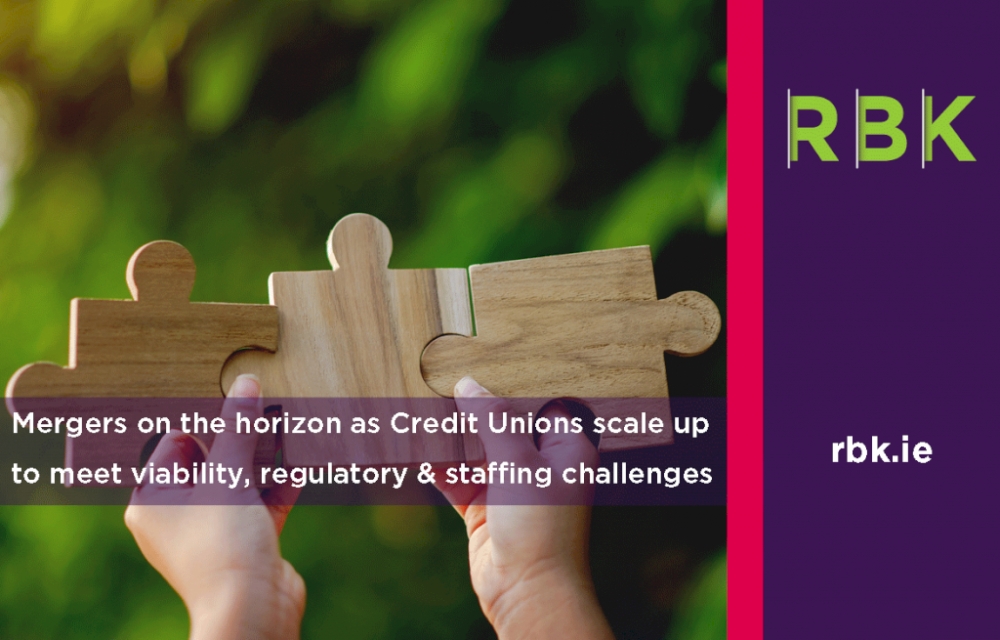In the last 5 years, the number of Credit Unions in Ireland has reduced by around 25% - a trend that looks set to continue according RBK Chartered Accountants whose 11th annual credit union benchmarking survey results will be published this week. Almost half (48%) of survey respondents said their credit union plans to merge in the next three years.
Driving the trend towards consolidation is a growing awareness of the advantages of scaling up as a means to access additional resources, address concerns about viability and take advantage of opportunities to innovate and develop new products and services.
Commenting on the results, RBK Partner Ronan Kilbane said, “Overall, 2022 was a broadly positive year for Credit Unions strengthened by the continued loyalty shown to the brand with it taking top spot for the 8th consecutive year in the CXI awards. Assets reached a record high, reserves remained strong, average loan book growth was up and loan to asset ratios grew slightly. However, inflation is driving up wages and with other costs also rising, careful management will be crucial in the months ahead to protect viability and sustainability.”
“Last year saw an uptake in merger activity as well as increased collaboration between credit unions in areas like product development. We anticipate further consolidation as credit unions join forces to strengthen their ability to take advantage of opportunities and compete more effectively in a rapidly changing macro-financial environment.”
Key findings:
- Loan book: Average loan book growth for 2022 was approximately 9.5% up from 4% in 2021. Consistent with previous years, the fastest growing loan types in 2022 were home improvement and car loans. While mortgage lending rose 6% when compared to 2021, there is still significant capacity for credit unions to increase their mortgage and business lending activity.
- Reserves: Average reserves were broadly stable at 16.2%. Strong reserves help to maintain confidence in the credit union sector.
- Costs: Expense to income ratios rose significantly in community credit unions in 2022 reaching 95%. While this was largely due to some exceptional pension costs and SPS refund , it highlights the importance of maintaining adequate reserves.
- Inflation: 45% of survey respondents predict inflation, cost control and branch profitability will be the top challenge in the next two years.
- Marketing: 82% of survey respondents said their credit union now has a dedicated marketing function in place. However, while more is being spent on marketing, our findings suggest the investment is not sufficiently strategically focused.
- Human Resources: Difficulties recruiting and retaining staff together with inflationary pressures in the economy are driving up wages. 80% of survey respondents said their credit union increased wages last year and 63% plan further wage increases in the next 12 months. 28% of survey respondents predicted that difficulties attracting and retaining staff will be a challenge over the next 24 months. This is a 12% increase when compared to the previous year.
- ESG: While 87% of survey respondents consider Environmental, Social and Governance (ESG) matters as part of their strategic planning process, almost 6 in 10 do not have a formal ESG policy in place, suggesting this is an area still lagging in terms of focus. Boards need to be able to show that the risks and opportunities associated with ESG and climate change are being identified and are feeding into their risk management and strategic planning processes.
- IT & Cyber: 15% of survey respondents indicated that their credit union experienced a known cyber attack in the last 12 months, up from 3% in the previous year. While staff awareness of cyber risks has improved, there is scope for father improvement.
About the survey:
RBK’s 11th Annual Credit Union Benchmarking Survey summarises the findings of a survey of credit unions conducted in March/April 2023. It reflects survey responses from 44 credit unions and financial data from 72 Credit Union published annual reports. Our sample of Credit Unions represents €10.54 billion or 51.9% of the total asset size of the Credit Union movement in the State. (The sector asset size was approximately €20.3 billion across 205 Credit Unions as at 30 September 2022). Prior year data has been updated to reflect additional information that became available after our 2022 Credit Union Benchmarking Report was published. Non-financial data in this year’s report refers to the current year to date and includes prior year comparisons where available.



